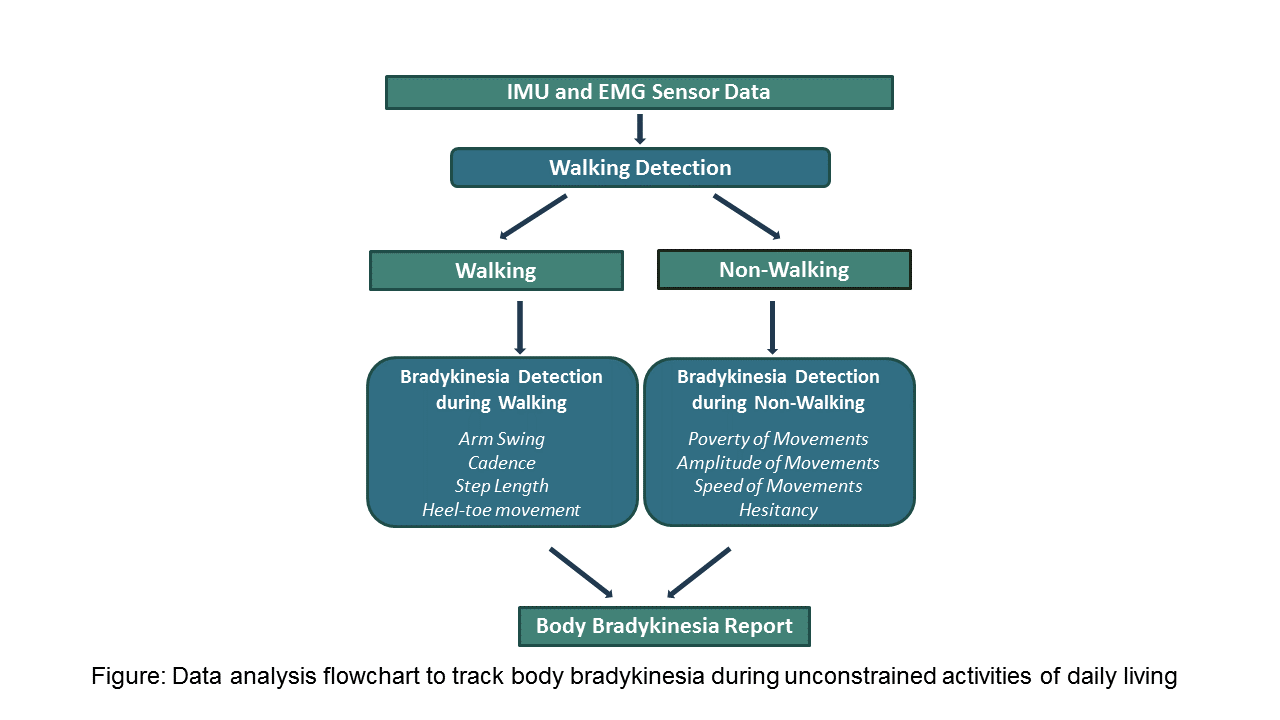Session Information
Date: Tuesday, June 6, 2017
Session Title: Technology
Session Time: 1:45pm-3:15pm
Location: Exhibit Hall C
Objective: To develop an algorithm for real-time automated detection of body bradykinesia during unconstrained activities using combined inertial measurement (IMU) and electromyographic (EMG) sensor data.
Background: Bradykinesia tracking using body-worn sensors has been successfully implemented for motor activities defined by the UPDRS, such as finger tapping and opening and closing of the hand. But these approaches lack a complete framework capable of monitoring the full complement of motor symptoms of whole body bradykinesia that occur throughout the day. We have developed machine-learning algorithms capable of real-time continuous detection of body bradykinesia from a reduced set of body-worn sensors during unconstrained activities in a simulated home environment.
Methods: EMG and IMU sensor data were recorded from n=17 PD patients (Hoehn & Yahr 1-3) during unconstrained activities of daily living over a 3-hour period. Sensors were placed on the upper- and lower-limbs of the more symptomatic side of the body. Annotation by movement disorder experts identified walking and non-walking activity states and body bradykinesia from video recordings. A feedforward neural network was first used to autonomously segment the data into walking and non-walking subclasses (Figure). Features during walking were extracted to capture arm swing, cadence, step length and heel-to-toe motion. For non-walking activities, features were extracted to capture paucity, amplitude, speed, and hesitancy of movement. Two multilayered feed-forward Dynamic Neural Networks (DNN) were developed to identify body bradykinesia during walking and non-walking separately using the features from each of the activity sub-classes. Algorithm training and accuracy measurements were performed using the annotation results as the truth.
Results: Walking and non-walking subclasses were identified by the algorithm with an accuracy of 99.5%. The DNNs identified body bradykinesia with an average accuracy of 95.0% for combined walking and non-walking activities. Classifications were provided for a temporal resolution of 1 minute.
Conclusions: The first autonomous body bradykinesia detector was successfully achieved from body-worn sensors. The approach provides a much-needed means of capturing bradykinesia in the context of unconstrained daily activity without the need for standardized motor tests at designated time intervals.
To cite this abstract in AMA style:
S. Roy, B. Shiwani, J. Kline, M. Saint-Hilaire, C. Thomas, M. Gennert, G. De Luca. Autonomous Tracking of Body Bradykinesia during Unconstrained Activities in Parkinson’s Disease [abstract]. Mov Disord. 2017; 32 (suppl 2). https://www.mdsabstracts.org/abstract/autonomous-tracking-of-body-bradykinesia-during-unconstrained-activities-in-parkinsons-disease/. Accessed November 25, 2025.« Back to 2017 International Congress
MDS Abstracts - https://www.mdsabstracts.org/abstract/autonomous-tracking-of-body-bradykinesia-during-unconstrained-activities-in-parkinsons-disease/

